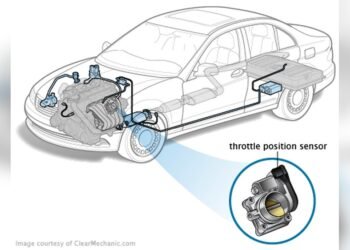A brake light not working can be frustrating. Especially when the bulb is fine.
Why does this happen? Understanding car issues can be tricky. One day, your brake light works. The next day, it doesn’t. You check the bulb, and it’s good. So, what could be wrong? There are several reasons this happens. It might be a wiring issue.
It could be a fuse problem. Or, it might be something else. In this blog, we will explore common causes. We will also offer solutions. Fixing this issue can keep you safe on the road. And it can help you avoid traffic tickets. Let’s dive into why your brake light might not be working and how to fix it.
Common Causes
Finding that one brake light is not working while the bulb is still good can be frustrating. This issue can stem from several common causes. Understanding these can help you pinpoint and resolve the problem quickly.
Wiring Issues
Wiring problems are a frequent cause of brake light failure. Over time, wires can become frayed or damaged. This can interrupt the flow of electricity to the brake light. Inspect the wiring for any visible signs of wear or tear. Loose connections can also be the culprit. Make sure all connections are tight and secure.
Blown Fuse
A blown fuse can disable your brake light. Fuses protect the electrical circuits in your vehicle. When a fuse blows, it breaks the circuit to prevent damage. Check your vehicle’s fuse box for any blown fuses. Replace any that are damaged. This simple fix can often restore your brake light to working order.
Credit: www.newbeetle.org
Checking The Bulb Socket
Is one of your brake lights not working even though the bulb is good? The issue might be with the bulb socket. A faulty socket can prevent the bulb from lighting up. Let’s explore some common problems that could affect the bulb socket.
Corrosion
Corrosion in the bulb socket can interrupt the electrical flow. This often happens due to moisture. Check for any rust or greenish buildup in the socket. Clean it with a wire brush or contact cleaner. This should restore the connection.
Loose Connections
Loose connections can also cause a brake light to fail. Inspect the wires connected to the socket. Ensure they are firmly attached. Sometimes, a simple push can fix the issue. If the wires are damaged, consider replacing them. A secure connection is essential for the brake light to work.
Inspecting The Brake Light Switch
When one brake light stops working, even though the bulb is good, the issue might be with the brake light switch. The brake light switch is a small but important component. It ensures your brake lights activate when you press the brake pedal. Let’s explore how to inspect the brake light switch.
Location
The brake light switch is usually located near the brake pedal. To find it, look underneath the dashboard, close to the top of the pedal. You may need a flashlight to get a clear view. The switch is a small device with wires connected to it. It could be attached with screws or clips.
Testing The Switch
To test the brake light switch, follow these steps:
- Press the brake pedal and listen for a clicking sound from the switch. If you hear a click, the switch is likely functioning. If not, it may be faulty.
- Use a multimeter to check the switch’s electrical continuity. Set the multimeter to the continuity or ohms setting.
- Disconnect the switch from its wiring harness. Place the multimeter probes on the switch terminals.
- Press the brake pedal and observe the multimeter. A reading indicates the switch is working. No reading suggests a faulty switch.
If the switch is faulty, replace it with a new one. Ensure the new switch is compatible with your vehicle’s make and model.

Credit: www.wikihow.com
Examining The Wiring
Sometimes, your brake light might stop working despite having a good bulb. This can be due to issues with the wiring. Properly examining the wiring can save time and prevent further damage. This process involves checking for broken wires and short circuits.
Broken Wires
Broken wires can disrupt the flow of electricity to the brake light. First, inspect the wiring harness connected to the brake light. Look for any visible damage or wear. If you find a break in the wire, it may need to be repaired or replaced.
Here’s a simple way to check for broken wires:
- Turn off the vehicle and remove the brake light assembly.
- Inspect the wires for any signs of damage.
- If you find a broken wire, use electrical tape to secure it.
- For a more permanent fix, solder the broken wire and cover it with heat shrink tubing.
Short Circuits
Short circuits can cause the brake light to fail. This occurs when the electrical current takes an unintended path. Check for any frayed or exposed wires that may be touching metal parts.
To identify short circuits:
- Turn off the vehicle and remove the brake light assembly.
- Inspect the wires for any signs of damage or wear.
- If you find exposed wires, cover them with electrical tape.
- Use a multimeter to check for continuity in the wiring.
By carefully examining the wiring, you can often resolve the issue of a non-working brake light. This can help you avoid costly repairs and keep your vehicle safe.
Testing The Fuse
If your brake light is not working, the fuse might be the issue. Even if the bulb is good, a blown fuse can stop the light from working. Testing the fuse is a simple process. It helps you figure out if this tiny piece is the problem. Let’s dive into the steps involved.
Fuse Location
The first step is to find the fuse box. In most cars, the fuse box is inside the car. It is often under the dashboard or near the glove compartment. Some cars have a second fuse box under the hood. Check your car’s manual for the exact location. It will save you time.
Replacing A Blown Fuse
Once you find the fuse box, you need to locate the brake light fuse. The car manual will help you find it. You can also look for a diagram on the fuse box cover. Remove the fuse carefully. Check if the metal wire inside is broken. If it is, the fuse is blown. Replace it with a fuse of the same rating. Push the new fuse into the slot. Make sure it is secure.
After replacing the fuse, test your brake light. If it works, you fixed the problem. If not, there might be another issue.
Assessing The Ground Connection
Experiencing issues with one brake light not working, despite a good bulb, can be frustrating. One potential cause is a problem with the ground connection. Let’s explore how to assess and fix the ground connection to get your brake light working again.
Identifying Ground Wire
The ground wire is critical for proper brake light function. Locate the ground wire by following these steps:
- Check the vehicle’s manual for the brake light wiring diagram.
- Look for the black wire connected to the brake light socket. This is usually the ground wire.
- If unsure, use a multimeter to test continuity. Place one probe on the chassis and the other on the wire. A beep or low resistance indicates the ground wire.
Ensuring Proper Grounding
Once you have identified the ground wire, ensure it is properly connected. Poor grounding can cause brake light issues. Follow these steps:
- Inspect the connection point where the ground wire meets the vehicle’s metal chassis.
- Look for corrosion, dirt, or loose connections. These can hinder grounding.
- Clean the connection point using a wire brush or sandpaper. Ensure a clean, metal-to-metal contact.
- Tighten any loose connections with a screwdriver or wrench.
If these steps do not resolve the issue, further electrical testing may be needed. Consider consulting a professional mechanic for a thorough diagnosis.
Using A Multimeter
When your brake light isn’t working but the bulb is good, using a multimeter can help. This tool measures electrical values in your car’s circuit. It helps find the issue quickly. This guide will show you how to use a multimeter to check your brake light system.
Measuring Voltage
First, set your multimeter to measure DC voltage. Turn on your car and press the brake pedal. Touch the multimeter’s black probe to the ground. This is usually the metal part of your car. Then, touch the red probe to the brake light socket contact.
If the multimeter shows a voltage reading, the circuit is getting power. If there’s no reading, you may have a wiring issue. This step confirms if the brake light socket gets power.
Checking Continuity
Next, you need to check the continuity of the circuit. Set your multimeter to the continuity setting. Remove the brake light bulb from the socket. Touch the probes to the contacts inside the socket. The multimeter should beep or show a low resistance reading.
If there’s no beep or the resistance is high, the circuit is broken. This means there’s a break in the wiring or a bad connection. Fixing these issues will restore your brake light.

Credit: www.youtube.com
Seeking Professional Help
When one brake light is not working, even though the bulb is good, it can be frustrating. Seeking professional help becomes necessary when you cannot fix the issue yourself. Professional mechanics have the skills and tools to identify the problem quickly. This can save you time and ensure your vehicle remains safe on the road.
When To Consult A Mechanic
Consult a mechanic if you have checked the bulb and it is still good. The issue might be with the wiring or the socket. A mechanic can check these parts thoroughly. If you notice other electrical problems in your car, it is also a good idea to seek help. Faulty brake lights can lead to accidents. So, do not wait too long to fix the issue.
Finding Reliable Service
Finding a reliable service is crucial for fixing brake light issues. Start by asking friends and family for recommendations. Check online reviews to see what others say about local mechanics. Look for a mechanic with experience in electrical systems. A good mechanic will explain the problem and the solution. They will also give you an estimate of the cost before starting the work. Trustworthy mechanics will not charge you for unnecessary repairs.
Frequently Asked Questions
Why Is One Brake Light Not Working But The Bulb Is Good?
The issue might be with the wiring, fuse, or brake light switch. Check these components.
How Do I Check The Brake Light Fuse?
Locate the fuse box, find the brake light fuse, and inspect it for damage or burn marks.
Can A Faulty Brake Light Switch Cause This Problem?
Yes. A bad brake light switch can prevent the brake light from working even if the bulb is good.
What Tools Do I Need To Troubleshoot Brake Light Issues?
Basic tools include a multimeter, screwdriver, and pliers. These help in checking connections and fuses.
Should I Consult A Mechanic For Brake Light Problems?
If you can’t fix it yourself, a mechanic can diagnose and repair the brake light issue professionally.
Conclusion
Fixing a brake light issue might seem tricky, but it’s doable. Start with checking the fuse. A blown fuse could be the problem. Next, inspect the brake light switch. This switch often causes issues. Also, ensure all wiring connections are secure.
Loose wires can disrupt the circuit. Lastly, consider consulting a professional if needed. It’s always better to be safe. Working brake lights are crucial for road safety. Stay proactive and keep your vehicle in top shape. Regular maintenance prevents bigger problems down the road.
Safe driving!















